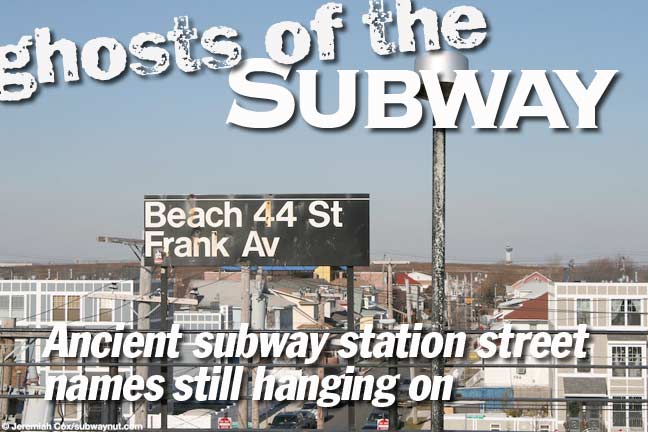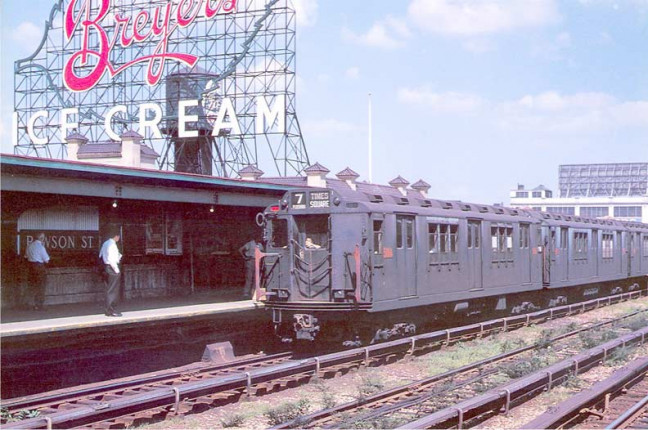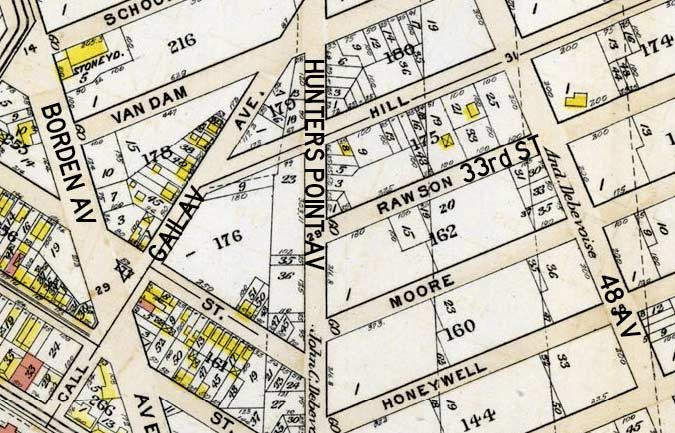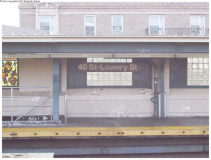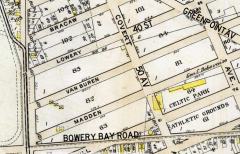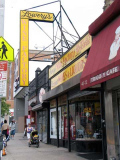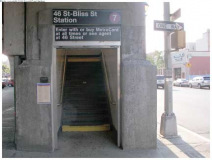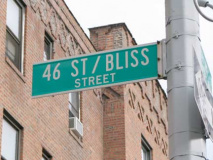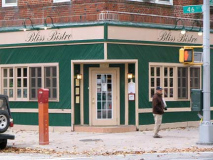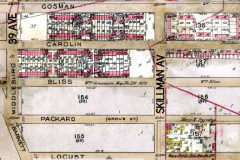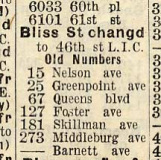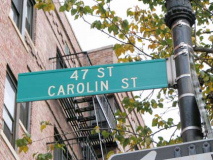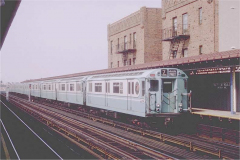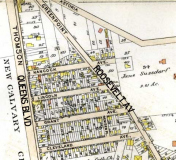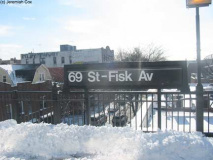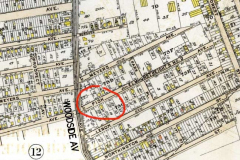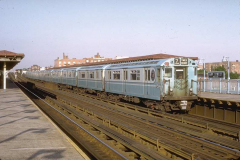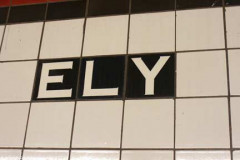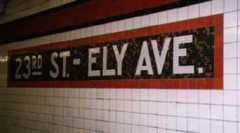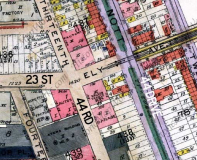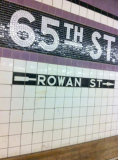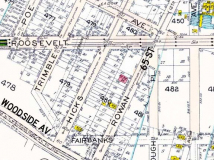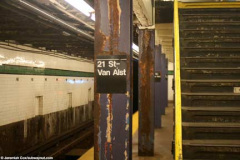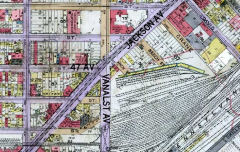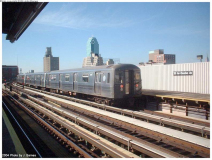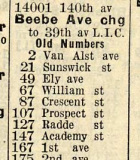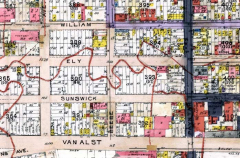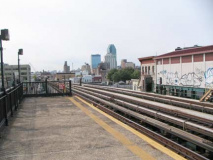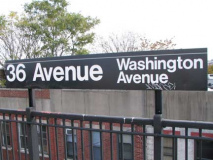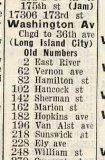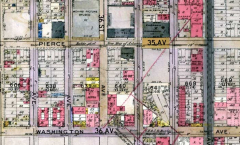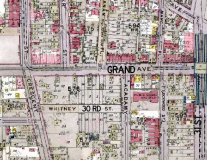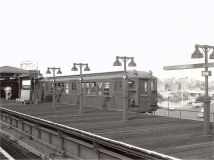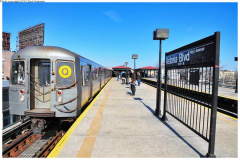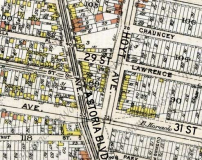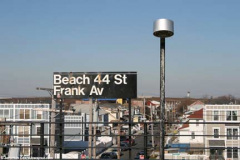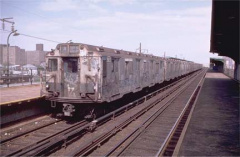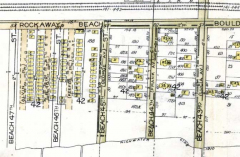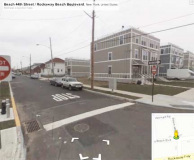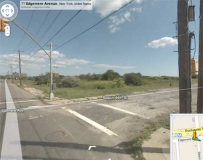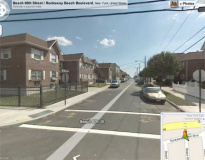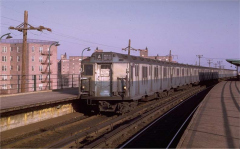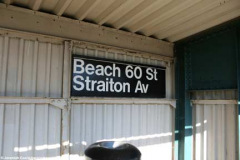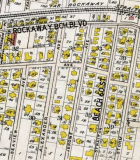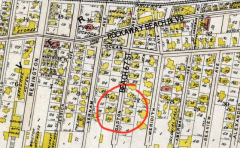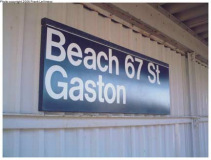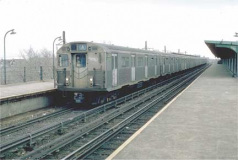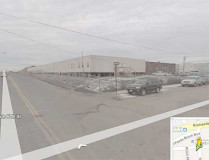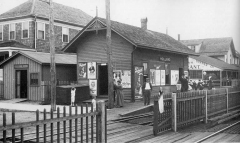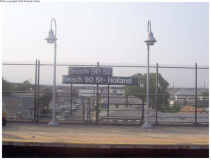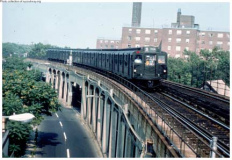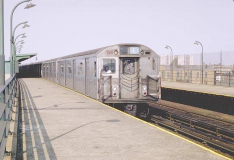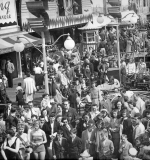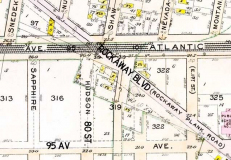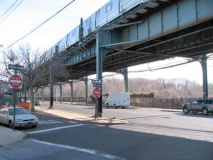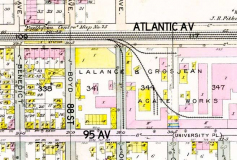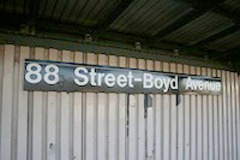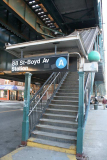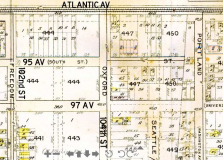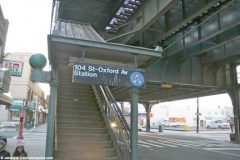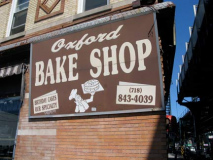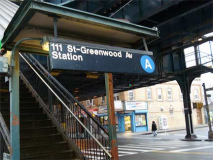The Forgotten NY Book of Street Necrology is a thick, dusty, ancient tome, encrusted with the grime of centuries, its lock rusting and the last flecks of gilt flaking off the bindery. Unlike the recent flimsy editions of the AIA Guide to New York City (whose pages separate from the glue binding soon after first use), the Book of Street Necrology was made during an age when pride was taken in craft and construction, and its pages, while making quite a meal for aphids, mites and other unwholesome, unnamed creatures, still adhere tightly and desperately to their binders; even as the crinkled, yellowed paper upon which is printed in Caslon the lost streets in NYC of centuries creaks and moans upon the opening of the cracked leather binder. The book plops open, and a bony finger, ending in an uncut nail, encircles its quarry and finally comes to rest upon one of the great lost subjects of the NYC subway system: the preservation of ancient street names in subway stations scattered around town.
No one quite knows why street names and locations that were renamed decades and, in some cases, nearly a century ago, still persist, and no one can tell you why some station names point to places and things that vanished eons ago. It’s even difficult to fathom why some of these older names were retained in the first place, since, in the case of Queens’ Ely Avenue, the street had been renamed as 23rd Street several years before the station appeared in the early 1930s. Those questions can only be answered by original subway designers and engineers such as Squire Vickers, and such secrets died when they did.
Flushing Line
Today’s #7 train runs between Times Square and Main Street, Flushing and has been “my” subway line since I moved to Queens in March 2003. The line has existed in its present form since 1928 when it was extended to Flushing; when it opened in 1917, it ran from Grand Central Terminal to Alburtis Avenue-Corona Plaza. In the early era of FNY, I discovered a tile sign at Hunters Point that read, “To Astoria and Corona,” reflecting the el extension along 31st Street to Ditmars Boulevard and the Corona terminal. By 1927 the line had been extended west to Times Square (plans call for a further extension to the Javits Center on 11th Avenue) and by the next year, east to Main Street.
As we’ll see, there are several ancient street names preserved in the station names…
In 1960 a set of R-14 cars arrives at the 33rd Street/Rawson Street station. It appears that at the time Rawson was the only street named on the signage, which then took the form of blue and white mosaics similar to those used elsewhere on the IRT and BMT underground stations. For many years a giant neon sign advertising Breyer’s Ice Cream loomed over the platforms; the superstructure for the ad is still in place, though the neon sign isn’t. This station provides a look at the Manhattan skyline from a different angle than the one the photographer took here. nycsubway
Along the Flushing Line the stations in Sunnyside still carry their old names, before the streets received numbers as a part of an overall plan hatched in the 1910s to standardize the street names of Queens, which had previously had a lot of repetition and duplication as the small towns that comprised the borough often had multiple Washington Streets, Main Streets, 1st and 2nd Avenues, and so on. The plan was gradually implemented throughout the 1920s and was mostly completed by the end of that decade, though there were pockets of resistance: much of downtown Flushing still carries plant names in honor of the gardens and plant nurseries that once dominated the town, and western Ridgewood was never numbered as it carries over the Brooklyn street layout and house numbering from neighboring Bushwick.
This 1909 Bromley atlas shows the Sunnyside street layout at a time when the streets were laid out on maps, but hadn’t yet been built up. Buildings show up as small yellow or orange squares. At the time 33rd Street (which I have helpfully overlaid on the map) was still Rawson, while 32nd Place was Hill Street, 34th was Moore, and 35th was still Honeywell, a small slice of which remains as a bridge over Sunnyside Yards. Interestingly what is now Gail Avenue was then Call Avenue, and I can’t help but think that the change ocurred because someone misinterpreted handwriting when ordering new street signs! Van Dam Street, which should have been renamed 32nd Street, kept its name perhaps because it was widened and extended south to Greenpoint Avenue.
Lowery/40th Street is next along the Flushing Line. Sunnyside streets took their names from Colonial-era landowners. Unusually, the old names are preserved in some cases — especially in Sunnyside Gardens north of Skillman Avenue — by two street signs or one sign with both names. The Bromley map shows 40th Street’s old name, Lowery, along with my own superimposed number.
Lowery Street is also remembered by this liquor store on Queens Boulevard and 40th Street
On the map:
Celtic Parkwas a recreational spot and sports center for the area’s large Irish population during the first quarter of the 20th century. The spot subsequently became a greyhound racetrack and is currently the site of the Celtic Park Houses apartment complex.
Old Bowery Bay Road was a colonial-era road stretching from Newtown Creek to the East River in what became Sunnyside, Astoria and Jackson Heights. It fell out of use over a century ago, but pieces remain such as Celtic Avenue (just below the D on Bowery Bay Road in the map, Hobart Street and 19th Road east of Hazen Street in Jackson Heights.
Street guide page from Red Book Information Guide to Queens, Interstate Map Co., 1928
While Bliss Street might be a cool name for a street (the owners of Bliss Bistro, 46th and Skillman Avenues think so) the street doesn’t honor a state of mind by the man who made this neighborhood of Sunnyside, and its adjoining cousins Blissville and Greenpoint possible.
Neziah Bliss, inventor, shipbuilder and industrialist, owned most of the land here in the 1830s and 1840s. Bliss, a protegé of Robert Fulton, was an early steamboat pioneer and owned companies in Philadelphia and Cincinnati. Settling in Manhattan in 1827, his Novelty Iron Works supplied steamboat engines for area vessels. By 1832 he had acquired acreage on both sides of Newtown Creek, in Greenpoint and what would become the southern edge of Long Island City. Bliss laid out streets in Greenpoint to facilitate his riverside shipbuilding concern and built a turnpike connecting it with Astoria (now Franklin Street in Greenpoint, Vernon Blvd. in Queens); he also instituted ferry service with Manhattan. Though most of Bliss’ activities were in Greenpoint, he is remembered chiefly by Blissville in Queens and by a stop on the Flushing Line subway (#7) that bears his family name.
As we’ve seen, the old names persist here including Carolin Street, or 47th; these signs are seen mostly in Sunnyside Gardens a few blocks north.
LEFT: Now, that’s how to paint a subway car. A baby blue World’s Fair R-33 is Manhattan bound at the 52nd Street (Lincoln Avenue) Flushing Line station in June 1970, long after the World’s Fair had been dismantled and left Flushing Meadows. This was also before the era when subways became rolling, graffiti-scrawled crime scenes, the “mugger-movers’ NYC radio host and Guardian Angels founder Curtis Sliwa is always referring to. The R-33s were later painted red, becoming the Redbirds running along several IRT lines including this one.
ON THE MAP: In an era prior to ours, Lincoln Ave. was a one block street running between Queens Boulevard (Thomson Avenue) and Greenpoint Avenue, which became Roosevelt (after president Theodore) in 1914 when the el began to take shape. The Jane Sussdorf estate is now partially occupied by the Mathews flats along Skillman Avenue and by Doughboy Park. nycsubway
CENTER: Before Queens streets were numbered, Fisk Avenue (69th Street) was a main road from Woodside south to Maspeth, the stretch between Woodside and Grand Avenues in particular. 69th Street today runs south of Grand to Metropolitan Avenue at All Faiths (Lutheran) Cemetery but before numbering, that part of it was called Juniper Avenue. photo left: Jeremiah Cox, Subway Nut
RIGHT: On a pleasant May day in 1972 a consist of R-36 World’s Fair cars arrives at the Manhattan-bound 69th Street-Fisk Avenue platform. We see the blue and white nameplates that used to announce station names as well as the old platform lightposts that held incandescent bulbs. The color coordination between the cars and paint on the railings and lamps was tip top. nycsubway
Queens Boulevard Line
The ancient street name pickings are rather slim on the IND Queens Boulevard line– there’s the Grand Avenue/Newtown station, for example. Newtown by the 1930s, when the station was built, had then been known as Elmhurst for four decades or so. There’s also Woodhaven Boulevard-Slattery Plaza, remembering Army engineer John R. Slattery (1877-1932); the full scoop is on FNY’s Rego Park page.
This 1909 Bromley atlas shows the Sunnyside street layout at a time when the streets were laid out on maps, but hadn’t yet been built up. Buildings show up as small yellow or orange squares. At the time 33rd Street (which I have helpfully overlaid on the map) was still Rawson, while 32nd Place was Hill Street, 34th was Moore, and 35th was still Honeywell, a small slice of which remains as a bridge over Sunnyside Yards. Interestingly what is now Gail Avenue was then Call Avenue, and I can’t help but think that the change occurred because someone misinterpreted handwriting when ordering new street signs! Van Dam Street, which should have been renamed 32nd Street, kept its name perhaps because it was widened and extended south to Greenpoint Avenue.
The 23rd Street/Ely Avenue station opened 8/19/33 and by then, Ely Avenue was no longer on the maps, having been replaced by 23rd Street. No doubt some oldtimers and diehards were still calling it Ely Avenue; the mystery is why the city didn’t put old Queens street names on more newly constructed IND stations in Queens — this is only one of two that does. The two maps are from 1917 and 1909 respectively — 44th Drive, where the station is, was called Nott Avenue before the numbering system was put in place.
This station, along with the 53rd Street and Lexington Avenue stops in Manhattan, marks the first pairing of the E and M trains in the subway system; the E was divorced here from longtime running buddy the F in the 1980s, and then the V in early 2010 when the latter was retired and the M rerouted here to take its place. Can the E and M coexist congenially? The E is a longtime 8th Avenue veteran, while the M has been ensconced in the Eastern Division hinterlands for decades and is finally stepping into the big time. Time will tell
The 23rd Street/Ely Avenue station opened 8/19/33 and by then, Ely Avenue was no longer on the maps, having been replaced by 23rd Street. No doubt some oldtimers and diehards were still calling it Ely Avenue; the mystery is why the city didn’t put old Queens street names on more newly constructed IND stations in Queens — this is only one of two that does. The two maps are from 1917 and 1909 respectively — 44th Drive, where the station is, was called Nott Avenue before the numbering system was put in place.
This station, along with the 53rd Street and Lexington Avenue stops in Manhattan, marks the first pairing of the E and M trains in the subway system; the E was divorced here from longtime running buddy the F in the 1980s, and then the V in early 2010 when the latter was retired and the M rerouted here to take its place. Can the E and M coexist congenially? The E is a longtime 8th Avenue veteran, while the M has been ensconced in the Eastern Division hinterlands for decades and is finally stepping into the big time. Time will tell.
Though the 65th Street station (at Broadway) doesn’t feature Rowan Street in its large nameplates, the little black tiled letters that point to the exits in IND stations still say Rowan Street, undoubtedly confusing newcomers to the area. You can’t see it on this 1917 excerpt but all old maps I have found of this area give Rowan Avenue as the original street name, not Rowan Street. Note that Roosevelt Avenue and its el, newly built in 1917, turn up for the first time. Trimble and Hicks Avenues survive as short roads off the Long Island Rail Road cut on either side of Woodside Avenue. The by-then eliminated Trains Meadow Road’s old path is still on the map, as well.
The M and the R are old pals, having been matched up on local BMT tracks in Brooklyn between Court Street and 36th Street before the M was rerouted to Queens and Manhattan.
Brooklyn-Queens Crosstown Line
Only one station on the Brooklyn-Queens Crosstown IND line sports a subway ghost name. The BQ Crosstown is the one and only subway line other than shuttles that never ventures into Manhattan.
It’s hard to show a photo of the 21st/Van Alst station without showing rust, as the poorly positioned and poorly drained station is subject to constant leaching from underground springs. Long Island City is a quickly-developing part of town, and having a subway station that visually recalls the bad old days of 1980s-style deferred maintenance is particularly emblematic of the conditions some non-Manhattan stations are in. The map shows the location of the station at 21st Street and Jackson Avenue. photo: Jeremiah Cox
Astoria Line
The Astoria Line opened in 1917 and was run by the IRT until 1949, when the BMT took it over. It has always had a close relationship with the Flushing Line that sprang from the connection both lines had with the Queensboro Bridge until 1942. The history is quite complicated — see the NYCSubway page for a detailed explanation. Most of its stations have kept the older street names that were in play when the line was opened in 1917, with modern numbers appended.
Street guide page from the Red Book Information Guide to Queens, Interstate Map Co., 1928
Above: a consist of R-68 subway cars is Manhattan bound at 39th/Beebe Avenue. The 1989 Citigroup tower, the tallest building in Long Island, is flanked by its predecessor as Queens’ tallest, the 1920s Bank of Manhattan clock tower in Queens Plaza. The station name is pronounced as it there were an extra “E” at the end: “Bee-bee.” photo: NYCSubway
Street guide page from the Red Book Information Guide to Queens, Interstate Map Co., 1928
Note the “Moving Picture Studio” on the map–it’s still there as Kaufman Astoria Studios and the adjacent Museum of the Moving Image.
Don’t call me a Redbird: in October 1969 a consist of Ditmars Boulevard bound R-16 cars arrives at 30th / Grand Avenue. Note the blue and white enamel station sign and former platform lamp stanchions, as well as the painted ad on the building behind the station. photo: NYCSubway
The 1919 area map shows the new el line along what was then 2nd Avenue but would be 31st Street in a number of years.
There’s still actually a Hoyt Avenue — in fact, Hoyt Avenues North and South, flanking the approach to the Triboro (RFK) Bridge opened in 1936 — but when the Astoria Line station was built in 1917, it was a single avenue, 31st Street was 2nd Avenue, and Astoria Boulevard was merely Astoria Avenue (it was promoted in rank to Boulevard in the late 1920s). Photos: in 1946, Low-V consist at Astoria Boulevard, then somewhat unusually named 25th Avenue (25th doesn’t intersect Astoria Boulevard) and a modern R-46 Q train. photos: NYCsubway.
Rockaway Line
This is in some ways one of the newer subway lines, as it opened in 1956 using trackage and infrastructure formerly a part of the Long Island Rail Road (the NY, Woodhaven and Rockaway Railroad began operations in 1877 and was leased to the LIRR beginning in 1904). The LIRR got tired of replacing a Jamaica Bay trestle that burned on numerous occasions, so the railroad sold it to the Transit Authority in the early 1950s for a bargain rate. What had been a grade railroad with traffic gates had already been elevated on a concrete structure in 1942, so it was ready-made for an urban transit line. By nomenclature it is an IND branch, but in name only as it doesn’t have the look and feel of the IND and retained many of its former LIRR station features, such as davit posts and diamond-shaped concrete blocks on the platforms. Major renovations to the platforms in the late 1990s and early 2000s brought them to the standards of other stations.
Frank
A number of stations on the Rockaway Branch line have old names appended to theBeach numbers (Rockaway has a Beach numbering system,, beginning at Beach 2nd and running west to Beach 200-something). The streets had had names for only a couple of decades before the “Beach” system was imposed. Many of Rockaway Beach’s side streets, like Frank Avenue (now Beach 44th) were originally built as planks across the sand dunes, leading to the now-vanished seaside mansions and later, bungalows, shown on the map by small yellow boxes. photos: NYCSubway, Subway Nut
Though Rockaway side streets north of the elevated have been recently been revitalized with new housing and the streets newly paved, south of the el tracks and along the waterfront, acre after acre remains unused and you have the spectacle of the elevated tracks and boardwalk stretching off into the distance and in between…nothing, occasionally broken up by a partially paved side street. This is the Edgemere of Reality.
Straiton
In January 1970 a consist of R-10 cars painted blue and white passes into the Straiton Avenue (Beach 60th Street) station. A scrawled sign in the front window says “Raise in Fare Unfair.” South of the tracks, Beach 60th is in fact inhabited as we see some tidy one and two family houses. photos by NYC Subway and Subway Nut
Gaston
In May 1982 an A train consisting of R-38 cars arrives at Beach 67th (Gaston Avenue). photos: NYCSubway, Subway Nut
In 2000 I found an abandoned synagogue at Larkin Avenue and Beach 67th; it burned down in 2003, and when the Google Photo Truck passed by in 2009, the corner looked like this.
Holland – Beach 90th
When the Holland LIRR station opened in 1880, it ran at grade, with a small ticket and baggage office; it was named for an adjacent hotel owned and operated by Michael P. Holland. Victorian Railroad Stations of Long Island, Ron Ziel & Richard Wetterau, 1988 Sunrise Special Ltd.
In 1942 the grade cross was eliminated and the railroad placed on a concrete trestle, which was taken over by the NYC Transit Authority in 1956 and connected to the subway network. An R-9 consist arrives at Beach 90th along the Hammels Wye, the Y-shaped connection between the Rockaway Park and Far Rockaway branches of the line.
Playland
Rockaway Playland, the peninsula’s answer to Coney Island, was in business between 1928 (as an amusement park in the classic sense; arious parks ha doperated at Rockaway Beach Boulevard, the boardwalk and Beach 98th Street since 1902) and the early 1980s. The roller coaster, named the Atom Smasher after World War II, was featured in the movie This Is Cinerama in 1952. The photos, from Old Queens, NY in Early Photographs by Vincent Seyfried and William Asedorian (Dover) show Playland at its peak in the 1940s and 1950s.
Today only the station signs indicate there ever was an amusement park right here; tract housing now occupies the space.
Above photo: in November 1970 an R-38 E train leaves the station. photo: NYCSubway
IND Fulton Street Line
The eastern end of the IND Fulton Street Line employs the former Fulton Street el tracks along Liberty Avenue, with the Fulton Street Subway line built in the mid 1930s and late 1940s, and the connection made in 1956 after the rest of the el had been torn down. Several stations along Liberty Avenue continue to subhead the older station names…
Hudson Avenue/80 Street
80th Street preserves Hudson Street (it was earlier called Bengal Street on maps), 88th, Boyd Avenue; 104th, Oxford Avenue; and 111th, and Greenwood Avenue. The map shows Hudson Street’s intersection with Atlantic Avenue a few blocks to the north. photo: Subway Nut
Boyd Avenue
A few blocks north of Liberty Avenue, Boyd Avenue (80th Street) bordered the Lalance & Grosjean enamelware factory; for more, inclusing their should-be-landmarked Atlantic Avenue clock tower, see FNY Woodhaven
104th/Oxford Avenue
When Queens still had mostly named streets, there was perhaps a surveyor in Woodhaven born in the Pacific Northwest, with street names like Seattle, Portland and Washington. The Oxford name survives at the Oxford Bake Shop.
Finally Greenwood Avenue is now 111th Street, with no trace but the station subtitle as well as the Greenwood Pharmacy on Liberty Avenue and 111th.
Thanks David Pirmann of NYCSubway and Jeremiah Cox of Subway Nut, saved me a lot of legwork and Metrocard charges…

